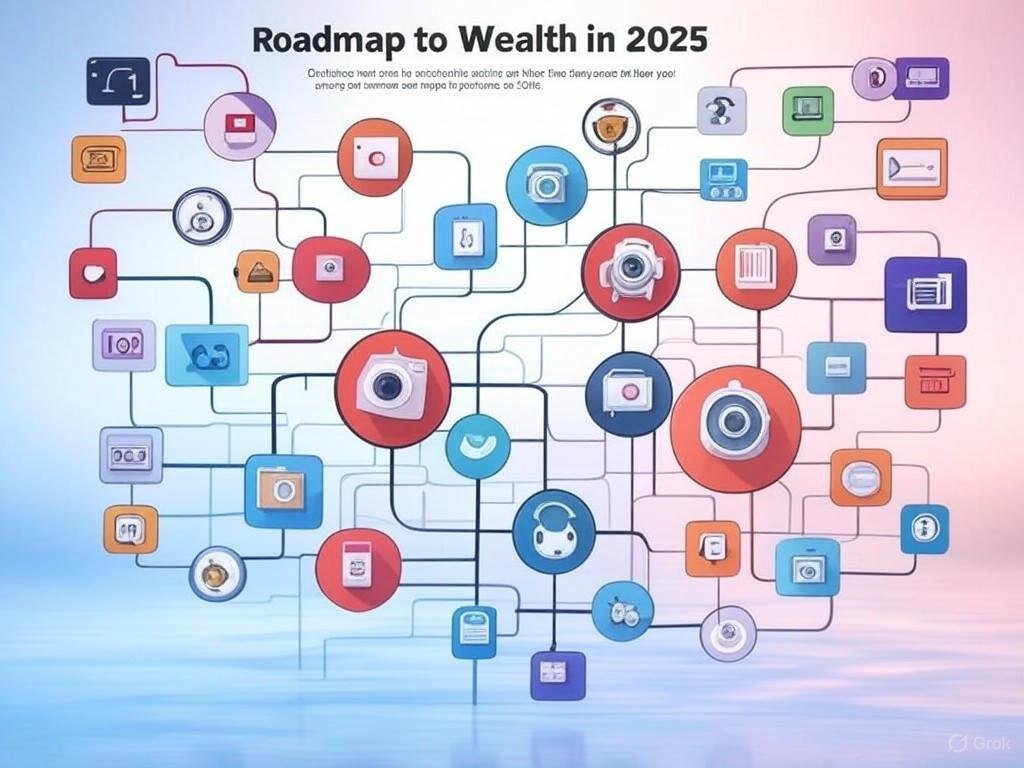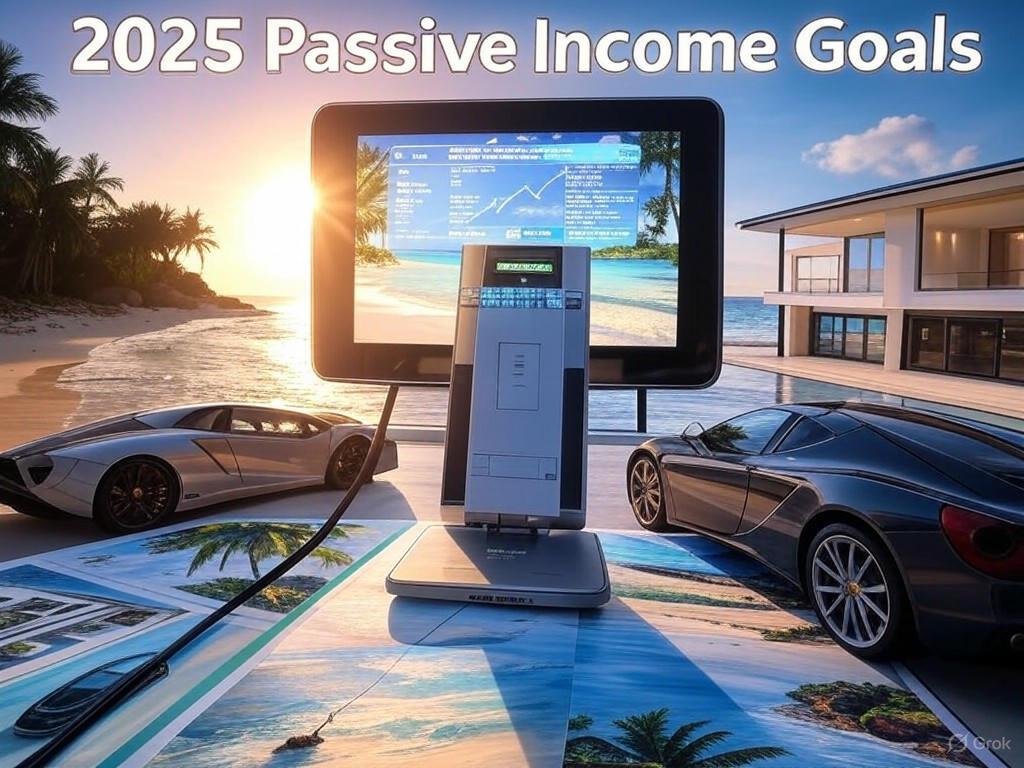The dream of earning money while you sleep is no longer just a fantasy—it’s a reality for millions who’ve tapped into the power of online passive income. In 2025, the digital landscape offers more opportunities than ever to create income streams that require minimal ongoing effort once set up. As someone who’s spent years navigating this space, I’ve seen what works, what doesn’t, and what’s worth your time. This guide dives deep into the best online passive income ideas, blending practical strategies with insights from my own experience and industry trends. Whether you’re a beginner or a seasoned entrepreneur, these ideas can help you build sustainable wealth.
What Is Passive Income, and Why Does It Matter?

Passive income is money earned with little to no daily effort after the initial setup. Unlike a traditional 9-to-5 job, where you trade hours for dollars, passive income allows you to leverage systems, technology, or investments to generate revenue over time. It’s not about getting rich quick—it’s about creating systems that work for you long-term.
Why focus on passive income? For one, it offers financial freedom. It can cover your bills, fund your dreams, or provide a safety net. In 2025, with rising costs and economic uncertainty, diversifying your income through online ventures is a smart move. Plus, the internet has made it easier than ever to start. From selling digital products to investing in automated businesses, the possibilities are vast.
Top Online Passive Income Ideas for 2025
Below, I’ve outlined the most effective and accessible online passive income ideas. Each one is vetted based on scalability, startup costs, and long-term potential. I’ll break down how they work, what you need to get started, and tips to maximize your success.
1. Create and Sell Digital Products
Digital products are a goldmine for passive income because they require no inventory, no shipping, and minimal upkeep. Think eBooks, online courses, templates, or printable planners. Once created, you can sell them repeatedly with little effort.
How It Works
You create a digital product based on your expertise or market demand—say, a guide to meal prepping or a Photoshop template for small businesses. Platforms like Gumroad, Etsy, or Teachable host your product, handle payments, and deliver files automatically. You promote it through social media, a blog, or email marketing, and the sales roll in.
Getting Started
- Identify Your Niche: Choose a topic you’re knowledgeable about or one with high demand (e.g., personal finance, fitness, or graphic design).
- Create the Product: Use tools like Canva for visuals, Google Docs for eBooks, or Kajabi for courses. Aim for quality but don’t overcomplicate it.
- Set Up a Sales Platform: Platforms like Gumroad charge minimal fees and integrate with payment systems like PayPal or Stripe.
- Market It: Share on Pinterest, Instagram, or through a blog optimized for keywords like “best digital downloads for [your niche].”
Why It’s Passive
Once the product is created and listed, sales are automated. You might spend a few hours a month updating content or marketing, but the heavy lifting is done upfront.
Pro Tip
Focus on evergreen content—products that stay relevant, like budgeting templates or coding tutorials. Update them annually to keep them fresh. In 2025, AI tools can help streamline content creation, but add your unique voice to stand out.
2. Affiliate Marketing
Affiliate marketing remains one of the most reliable passive income strategies. You earn a commission by promoting other people’s products through links on your blog, social media, or YouTube channel.
How It Works
You sign up for affiliate programs like Amazon Associates, ShareASale, or ClickBank, which offer products in nearly every niche. You create content—blog posts, videos, or social media posts—that includes your unique affiliate links. When someone buys through your link, you earn a commission, typically 5-50% of the sale price.
Getting Started
- Choose a Niche: Focus on a specific area, like tech gadgets or sustainable fashion, to build authority.
- Build a Platform: A blog or YouTube channel works best for long-term success. Optimize content for keywords like “best [product] reviews 2025.”
- Join Affiliate Programs: Start with beginner-friendly programs like Amazon Associates, then explore higher-paying ones like Bluehost for web hosting.
- Create Content: Write in-depth reviews, comparisons, or how-to guides. For example, a post titled “Top 10 Eco-Friendly Products for a Greener Home” can include affiliate links to each item.
Why It’s Passive
Once your content is live, it can generate clicks and commissions for months or years with minimal updates. A single blog post can earn money while you focus on creating more content.
Pro Tip
Use SEO tools like Ahrefs or Semrush to find low-competition keywords related to your niche. For example, target “best budget laptops for students” instead of just “laptops.” Also, disclose affiliate links transparently to build trust with your audience.
3. Start a Blog with Ad Revenue
Blogging isn’t just a creative outlet—it’s a powerful way to earn passive income through ads, sponsored posts, and affiliate links. While it takes time to build traffic, a well-optimized blog can become a cash cow.
How It Works
You create a blog on a platform like WordPress, write content that attracts readers, and monetize through ad networks like Google AdSense or Mediavine. As traffic grows, you can also pitch sponsored posts or sell your own products.
Getting Started
- Pick a Niche: Choose a topic you’re passionate about, like travel, parenting, or personal finance. Narrow it down to something like “budget travel for families.”
- Set Up Your Blog: Use WordPress with a reliable host like SiteGround. Invest in a clean, user-friendly theme.
- Create Quality Content: Write posts that solve problems, like “How to Save $1,000 on Your Next Vacation.” Optimize for keywords like “passive income ideas for beginners.”
- Monetize: Apply for ad networks once you hit 10,000-25,000 monthly page views. Mediavine and AdThrive offer higher payouts than AdSense.
Why It’s Passive
Once your blog gains traction, older posts continue to drive traffic and revenue. You can batch-create content and schedule posts to minimize ongoing work.
Pro Tip
Focus on SEO to rank higher on Google. Use long-tail keywords like “how to start a blog for passive income” and create cornerstone content that links to related posts. Guest blogging on reputable sites can also boost your authority.
4. Build an Online Course
Online courses are booming in 2025, with people eager to learn skills like coding, photography, or digital marketing. If you’re an expert in a field, packaging your knowledge into a course can yield significant passive income.
How It Works
You create a course with video lessons, quizzes, and downloadable resources, then host it on platforms like Teachable, Udemy, or Thinkific. Students enroll, and you earn revenue with each sale.
Getting Started
- Choose Your Topic: Pick something you’re skilled at, like “Mastering Adobe Photoshop” or “Beginner’s Guide to Cryptocurrency.”
- Record Content: Use tools like Camtasia or Loom for screencasts and a decent microphone for clear audio.
- Host the Course: Platforms like Teachable automate enrollment and payments. You can also sell courses on your own website for higher margins.
- Promote It: Use social media, email marketing, or a blog to drive traffic. Offer a free mini-course to attract leads.
Why It’s Passive
Once the course is live, enrollments happen automatically. You might answer occasional student questions, but platforms handle most of the logistics.
Pro Tip
Create a sales funnel with a free webinar or email series to convert leads into buyers. Optimize your course landing page with keywords like “best online course for [your topic].”
5. Invest in Dividend-Paying Stocks or ETFs
While not strictly an “online” venture, managing dividend-paying investments through online platforms makes this a viable passive income source. Apps like Robinhood, Fidelity, or Vanguard let you invest with ease.
How It Works
You buy stocks or exchange-traded funds (ETFs) that pay dividends—regular payouts from companies to shareholders. Reinvest dividends to compound your earnings or use them as passive income.
Getting Started
- Research Stocks/ETFs: Look for companies with a history of consistent dividends, like Coca-Cola or Procter & Gamble. ETFs like VYM (Vanguard High Dividend Yield) diversify your risk.
- Choose a Platform: Use low-fee brokers like Fidelity or Charles Schwab.
- Start Small: You don’t need thousands to begin. Many platforms allow fractional shares, so you can invest with as little as $50.
- Automate: Set up automatic reinvestments to grow your portfolio over time.
Why It’s Passive
Once your portfolio is set, dividends are paid regularly without additional work. You might review your investments quarterly, but it’s low-maintenance.
Pro Tip
Focus on dividend aristocrats—companies that have increased dividends for 25+ years. Use platforms like Seeking Alpha for research, and diversify to mitigate risk.
6. Create a YouTube Channel
YouTube is a powerhouse for passive income, thanks to ad revenue, sponsorships, and affiliate marketing. Videos can earn money long after you upload them.
How It Works
You create videos in a niche like tech reviews, cooking, or fitness, then monetize through YouTube’s Partner Program (ads), sponsorships, or affiliate links. Evergreen content, like tutorials, performs best for long-term income.
Getting Started
- Choose a Niche: Pick something you enjoy, like “home workouts for beginners” or “budget travel tips.”
- Create Content: Use a smartphone or basic camera to start. Edit with free tools like DaVinci Resolve.
- Optimize Videos: Use keyword-rich titles like “How to Start a Side Hustle in 2025” and engaging thumbnails.
- Monetize: Apply for the YouTube Partner Program after hitting 1,000 subscribers and 4,000 watch hours.
Why It’s Passive
Once uploaded, videos can generate views and revenue for years. You’ll need to post regularly to grow, but older content keeps earning.
Pro Tip
Use TubeBuddy or VidIQ to find trending keywords. Create playlists to keep viewers watching, boosting your watch time and ad revenue.
7. Rent Out Digital Assets
Got a website, domain, or social media account with traffic? You can rent out digital real estate for passive income.
How It Works
Websites with steady traffic can lease ad space or guest post slots. Unused domains can be rented or sold on platforms like Flippa. Social media accounts with large followings can charge for shoutouts.
Getting Started
- Build or Buy an Asset: Create a blog or buy an established one on Flippa. Grow a social media account in a niche like fitness or finance.
- Monetize: Use platforms like BuySellAds for ad space or reach out to brands for sponsored posts.
- Automate: Use tools like Calendly to schedule rental agreements or automate ad placements.
Why It’s Passive
Once the asset is established, rentals require minimal effort. You might negotiate deals occasionally, but the income is largely hands-off.
Pro Tip
Focus on niches with high advertiser demand, like tech or health. Optimize your site for keywords like “monetize your blog” to attract organic traffic.
Read more: Get Paid to Answer Questions – A Proven Method for Earning Income
Tips for Success in Building Passive Income
- Start Small, Scale Up: Don’t try all these ideas at once. Pick one, master it, then diversify.
- Invest in Learning: Spend time understanding SEO, marketing, or investing to maximize returns.
- Be Patient: Passive income takes upfront work. Most streams take 6-12 months to gain traction.
- Track Results: Use tools like Google Analytics or portfolio trackers to monitor performance and tweak strategies.
- Stay Consistent: Whether it’s posting blogs or creating videos, consistency builds momentum.
Common Pitfalls to Avoid

- Expecting Instant Results: Passive income requires upfront effort. Don’t quit if you don’t see immediate profits.
- Ignoring Quality: Low-effort content or products hurt your reputation. Invest in creating value.
- Overcomplicating Systems: Automate where possible, but keep processes simple to avoid burnout.
- Neglecting Taxes: Passive income is taxable. Consult a tax professional to stay compliant.
Read more: Earn Money Online Without Investment by Typing: A Personal Journey to Financial Freedom
Why 2025 Is the Year to Start
The digital economy is thriving, and 2025 is ripe with opportunities. Advancements in AI, automation, and online platforms have lowered barriers to entry. Whether you’re creating a course, investing in stocks, or starting a blog, the tools and markets are more accessible than ever. Plus, with economic shifts pushing people toward side hustles, now’s the time to carve out your niche.
Final Thoughts
Building online passive income isn’t a get-rich-quick scheme—it’s a strategic way to create financial stability and freedom. By leveraging digital products, affiliate marketing, blogging, or investments, you can create streams that pay off for years. Start with one idea, commit to learning, and scale as you grow. The journey takes effort, but the reward—time and financial freedom—is worth it.
Which of these ideas resonates with you? Start small, experiment, and watch your income grow. Here’s to building wealth in 2025 and beyond!



